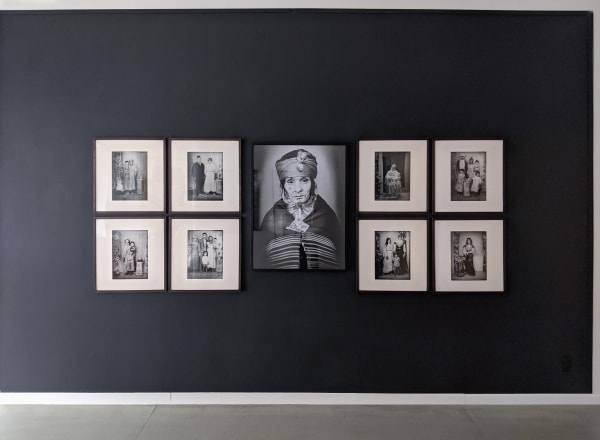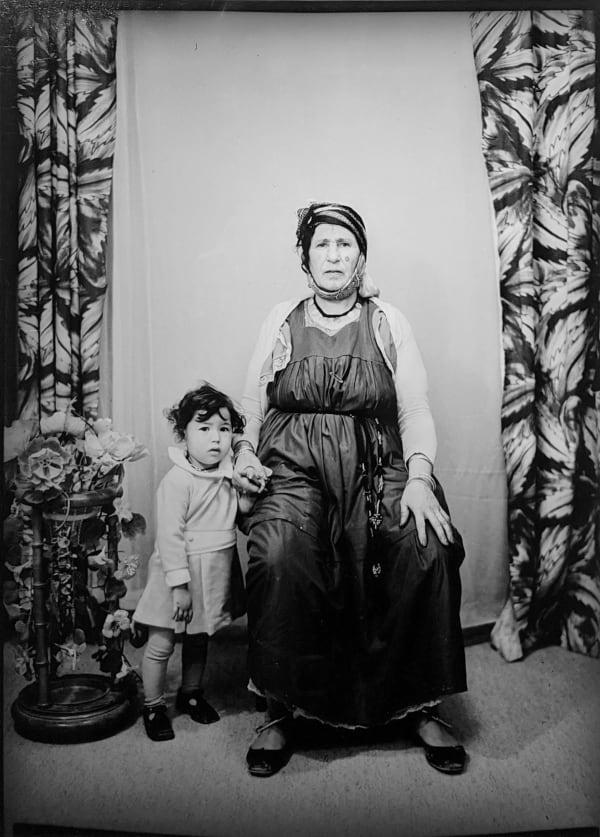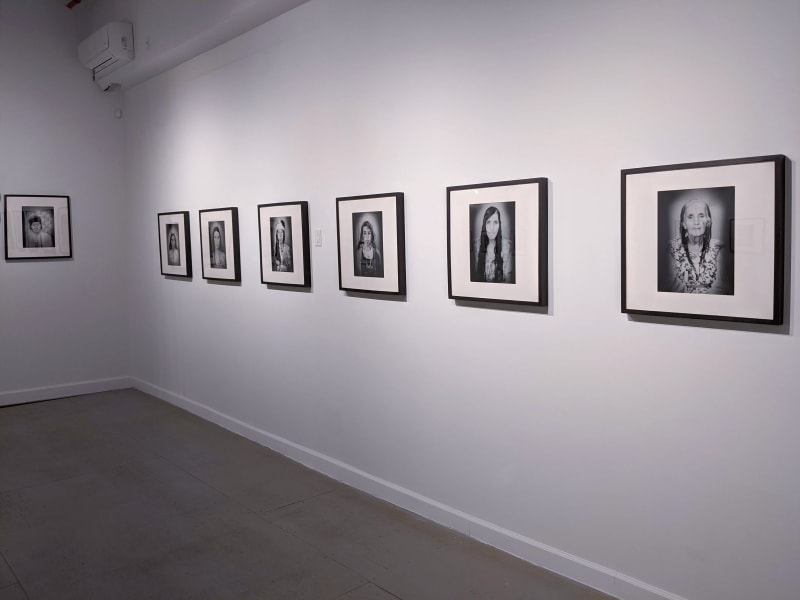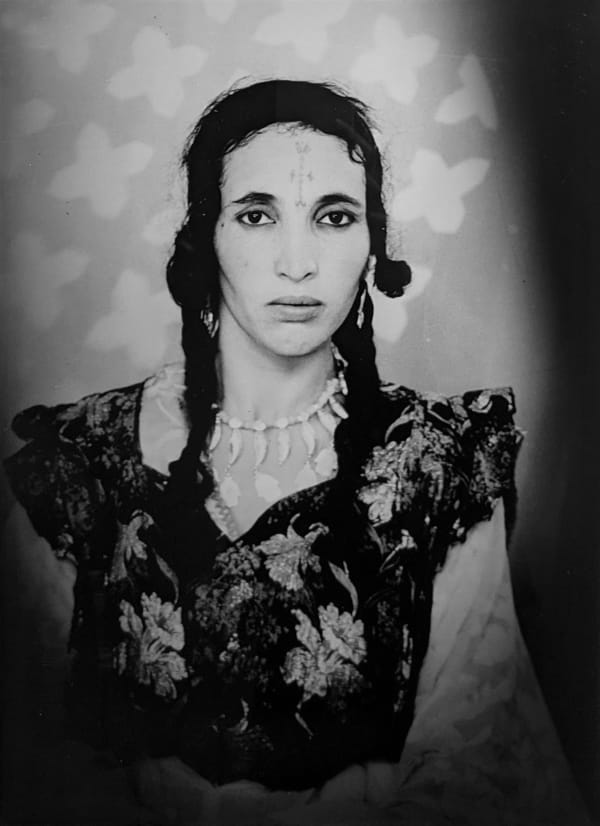Lazhar Mansouri: Lifting the Veil: Portraits of Amazigh Women
WESTWOOD GALLERY NYC presents Lifting the Veil: Portraits of Amazigh Women, a solo exhibition of photography by Lazhar Mansouri (1932–1985). The show features thirty-five gelatin silver prints highlighting Amazigh women from Aïn Beïda, Algeria, taken between the 1950s and 1970s.
Mansouri captures women in a rare moment without their veils, preserving the fading tradition of facial tattoos and the symbolic patterns they carry. His portraits honor the cultural strength, artistry, and leadership of Amazigh women, documenting their role in sustaining heritage through textile, jewelry, and ritual practices.
Working with care and discretion, Mansouri creates intimate, respectful images that reveal both individual presence and centuries-old cultural history.
-
 Lazhar Mansouri, Untitled, circa 1960s
Lazhar Mansouri, Untitled, circa 1960s -
 Lazhar Mansouri, Untitled, circa 1960s
Lazhar Mansouri, Untitled, circa 1960s -
 Lazhar Mansouri, Untitled, circa 1960s
Lazhar Mansouri, Untitled, circa 1960s -
 Lazhar Mansouri, Untitled, circa 1960s
Lazhar Mansouri, Untitled, circa 1960s
-
 Lazhar Mansouri, Untitled, circa 1960s
Lazhar Mansouri, Untitled, circa 1960s -
 Lazhar Mansouri, Untitled, circa 1960s
Lazhar Mansouri, Untitled, circa 1960s -
 Lazhar Mansouri, Untitled, circa 1960s
Lazhar Mansouri, Untitled, circa 1960s -
 Lazhar Mansouri, Untitled, circa 1960s
Lazhar Mansouri, Untitled, circa 1960s
-
 Lazhar Mansouri, Untitled, circa 1960s
Lazhar Mansouri, Untitled, circa 1960s -
 Lazhar Mansouri, Untitled, circa 1960s
Lazhar Mansouri, Untitled, circa 1960s -
 lAZHAR mANSOURI, Untitled, circa 1960S
lAZHAR mANSOURI, Untitled, circa 1960S -
 lAZHAR mANSOURI, Untitled, circa 1960S
lAZHAR mANSOURI, Untitled, circa 1960S
-

Lazhar Mansouri: Lifting the Veil, Portraits of Amazigh Women | Installation View
-
 Lazhar Mansouri: Lifting the Veil, Portraits of Amazigh Women | Installation View
Lazhar Mansouri: Lifting the Veil, Portraits of Amazigh Women | Installation View -
 Lazhar Mansouri: Lifting the Veil, Portraits of Amazigh Women | Installation View
Lazhar Mansouri: Lifting the Veil, Portraits of Amazigh Women | Installation View -
 Lazhar Mansouri: Lifting the Veil, Portraits of Amazigh Women | Installation View
Lazhar Mansouri: Lifting the Veil, Portraits of Amazigh Women | Installation View -
 Lazhar Mansouri: Lifting the Veil, Portraits of Amazigh Women | Installation View
Lazhar Mansouri: Lifting the Veil, Portraits of Amazigh Women | Installation View
Westwood Gallery NYC was pleased to present Lifting the Veil: Portraits of Amazigh Women, a solo show of photography by Lazhar Mansouri (1932-1985). On view were thirty-five gelatin silver photographs representing only a small portion of over 10,000 portraits captured during his lifetime. This is the second exhibition of portraiture at Westwood Gallery NYC by the Algerian photographer and focuses on Amazigh (Berber) women, circa 1950s to 1970s from his hometown of Aïn Beïda (near the Aurès Mountains), Algeria. This exhibition is one of a series of rediscovered artist estates, as part of the gallery core program.
Mansouri’s portraits captured one of the last generations of Amazigh women to undergo the facial tattooing process. The tattooing is less practiced today, mostly due to the disappearance of the adasiya, wandering gypsy tattooists from Tunisia, and the growing Islamization in the Aurès Mountains after the collapse of French Algeria in 1962. With the rise of Islam came the prohibition of tattooing as haram, and the veiling of women as mandatory. For most of the women who arrived to Mansouri’s studio, this was the first time they had taken off their veil for any man except their husband, making the photographic archive Mansouri created exceptional.
In Mansouri’s portraits on view, the fading tradition and history of Amazigh face tattoos is preserved on the faces of many women. The shapes, which include a sun (shams), a palm tree, a chain (cinsla), and flies (thabanat), were considered enhancers of beauty when applied to the face. Another significant shape is the diamond or eye of a partridge (ain hijla), which takes its symbolic significance from the partridge, a bird of great grace and beauty to Amazigh culture; its sharp eyes are thought as vigilant watchers against danger.
Historically, Amazigh women have been associated with freedom, boldness, and political leadership, and were fundamental to Amazigh culture in preserving rituality, orality, and art. This legacy can be traced back to pre-Islamic times, and the uncrowned Amazigh queen and warrior Kahina (born in the Aurès Mountains in Algeria in the 7th century) whose name means ‘prophetess’ for her ability to foresee the future and lead her people to temporarily hold conquering Arab armies from introducing Islam to the local Amazigh tribes. Throughout North African history, Amazigh women were responsible for the orality of the Amazigh language, passing it down from generation to generation as an extension of the tribes’ matrilineal beliefs. In addition, Amazigh women were the protectors and proliferators of art, expressing their skill into textile weaving, jewelry construction, and hand and feet decoration.
Mansouri described his respectful approach in photographing individual female portraits to document a centuries-old tradition:
"Women often come accompanied by a relative. They follow the man, veiled, not to be recognized in the street. When they come in the studio they submit to my rules. The only person that comes in is the one who wants the photograph. The person to be photographed has some space to fix her or his appearance, a small hand mirror, one on the wall, a hairbrush and combs. Generally, women come wearing makeup, well dressed, with jewelry. A certain distance is imposed otherwise it would be a sign of disrespect for a man to be too close to a woman. The clients are very different and it is almost impossible to tell who has been in a studio before and knows the procedure and who has never seen a camera and needs instruction. The approach has to be very delicate in order to avoid shame, especially since for some of them it is the first time when they are without veil in front of a man they are not related to. Sometimes, I have to intervene if the hair covers the face, or jewelry is not placed where it should be. Then I try to arrange it, but I take all the precautions of language and discretion.”
-

Middle East Eye's picks of the year 2020
Lazhar Mansouri; Lifting the Veil: Portraits of Amazigh WomenMiddle East Eye, 31 Dec 2020 -

Lazhar Mansouri, Lifting the Veil: Portraits of Amazigh Women
Amandine Meunier, L'Intimiste, 27 Nov 2020 -

In pictures: The hidden lives of the Amazigh people
Ouissal Harize, Middle East Eye, 29 Jun 2020 -

Lazhar Mansouri: Portraits of Amazigh Women at Westwood Gallery NYC
Musee Magazine, 25 Jan 2020

























